Vega Bray and the 2001 Leonids
Written for the NOVAC newsletter; January 2001
Also published in Amateur Astronomy Magazine #35
Bummer! As of 2010 Vega Bray is no longer a bed and breakfast place. It is still open as an educational facility.
The Leonids of 2001 were spectacular from the dry, dark skies of southeastern Arizona. Peaking at more than 1000 per hour and having a two-hour window of 500 per hour or greater made it the most spectacular and exciting meteor shower of my life.
The Trip to Vega-Bray
My adventure began last spring (2001) when I saw an ad in The Reflector, the quarterly
publication of The Astronomical League, from a company called Skycamping
Worldwide (since gone defunct) which
organized trips with astronomical folks in mind. Upon visiting their website
I discovered a planned 3-night, 4-day trip to Arizona for the Leonid meteor
shower predicted for Saturday night, November 17-18. I signed up but, as
it turned out, the trip was eventually cancelled due to insufficient interest.
Nevertheless, as the trip was being cancelled, I asked to take over the Friday
night (Nov. 16) reservation which had been made at the Vega-Bray Bed, Breakfast,
and Observatory
(http://www.skywatchersinn.com/;
see Sky and Telescope, August, 1999 for a review), determined to go on my
own to Arizona. Inquiring with Vega-Bray I found, remarkably, that there
was a room available for Saturday night and took it. After further inquiries
I discovered that, although they were full on Thursday night, I could stay
at a local motel (10 minutes away) and, for $45, could spend the evening
at Vega-Bray and use any of their telescopes. So I was set with three nights
under dark Arizona skies with telescopes ranging from 8-inches to 18-inches
at my command, and the prediction of 1500 meteors/hour for early (3 am) Sunday
morning!
On Thursday, an 8:00 am flight out of Baltimore-Washington Airport got me into Phoenix by 11:00 and, in my rental car, into Tuscon, by 2:00 pm. Vega-Bray is 45 miles east of Tuscon and is situated 10 minutes out of the small town of Benson. After checking into Motel 8, I went over to Vega-Bray to see the facilities and determine which telescope I would use that evening. The folks were very nice and the range of telescopes was outstanding. I chose an 18-inch JMI split ring reflector which is housed in a roll-off roof observatory which also houses two 12-inch Meade LX200s, an historical 14.5" Newtonian on a wooden German Equatorial Mount (with all-wooden gears), and an 8" f/7 homemade Newtonian scope optimized for planetary viewing. There were also 12 and 8-inch commercial dobsonians stacked against the wall. In a separate dome was a 20" f/10 Maksutov Cassegrain made by Max Bray on a mammoth German Equatorial Mount; very impressive, but not something I felt comfortable piloting. In yet another dome was another 12-inch LX200 and, I discovered later, a very fine 10-inch truss-tube reflector on a Dobsonian mount. Additionally, on a large observing deck there were two pair of giant (110 mm and 150 mm) binoculars on permanent alt-az mounts. Thus, there was no shortage of equipment.
Roll-off observatory Vega Bray on the hill 12-inch and Dome
 |
 |
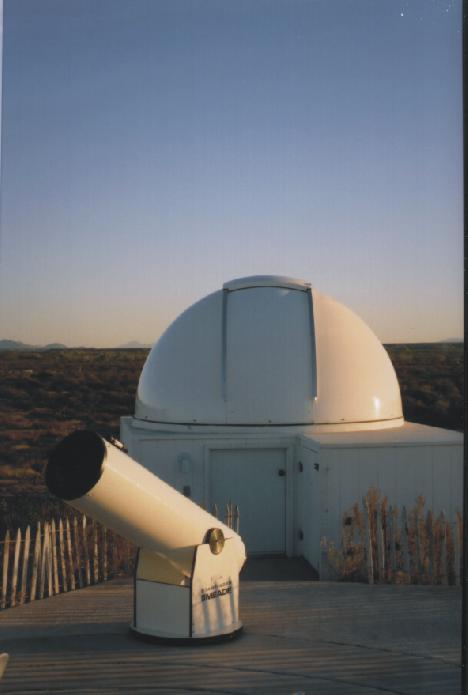 |
The First Night, a Dissappointment
Although the beds were full at Vega-Bray that night, There was only myself
on the JMI and an elderly couple on an LX200 who were observing. The couple
was being given a nice sky tour and an 'Astronomy 101' lecture by Mike, an
astonomer at Kitt Peak who also sometimes gives sky tours at Vega-Bray. By
7:00 the sky was becoming very dark and the winter Milky Way began to shine
brightly. That evening proved to be, however, quite disappointing. The optics
on the JMI seemed rather poor and its design, which allows the whole top
of the scope (with eyepiece and secondary mirror) to spin around so that
the eyepiece is always at a convenient spot, made stable collimation essentially
impossible. Mike confirmed my fears and I switched to the other 12-inch LX200.
This scope was also in bad repair and I could not get sharp images due, I
think, to the focusing mechanism being very sloppy. In addition to the poorly
maintained scopes, the walls of the roll-off observatory cut off any viewing
below about 40 degrees from the southern horizon. Thus, I went to bed around
midnight wondering if I had made a mistake in choosing to come to Vega-Bray.
The Second Night was Great
In spite of this, on Friday I moved into Vega-Bray for the next two nights.
I met another 'resident astonomer' named Olivia who was incredibly helpful
and who put a finder scope on a 12-inch Meade Dobsonian (which also had a
Telrad). She also had her husband repair a camera tracker for my use during
the Leonids. That evening, which was also crystal clear, I moved the 12-inch
Dob out onto the observing deck and collimated it after dark. On the observing
deck I met two newcomers, Will, a geologist from Texas A&M, and Simon,
a Brit currently living in New York. Will and Simon became my observing partners
for the next two nights. I borrowed the Herald-Bobroff AstroAtlas from the
well-stocked library at Vega-Bray and, as the night got darker, began in
Sculptor with the plan of moving south. The telescope proved to be excellent,
giving crisp, high-contrast images. Eddie Vega (Ed Vega's son) recommended
that we also try the 10-inch truss-tube Dob that was made by a friend of
his. So we set it up next to the 12-inch. This proved to be a marvelous choice
as this telescope, too, had excellent optics. The 10-inch appeared to be
about an f/4.5 and had a 2-inch focuser into which I put my 32 mm wide field
Brandon eyepiece giving approximately 1.8 degrees of field. This allowed
remarkably wonderful images of several large objects (double cluster, M31/32/110,
Pleiades, Beehive, etc.). With the 12-inch I found the edge-on galaxy NGC
253 which practically jumped out of the eyepiece and showed quite a lot of
mottling and apparent dust lanes. Using a 14 mm Pentax the bright galaxy
spanned the entire field of view. Because of the southerly latitude, low
humidity, and lack of (southerly) light pollution, we were able to move south
to NGC 300 (large and faint) and NGC 55, another big edge-on that nearly
filled the eyepiece. Both of these fine galaxies, being nearly at 40 degrees
south declination, are nearly impossible to see from northern Virginia, but
were both excellent objects from Vega-Bray. Similarly, we were able to poke
around in the Fornax Galaxy Cluster and find several faint fuzzies. As the
night wore on, we alternated between northern showpieces like the Veil supernova
remnant, globular clusters such as M15 and M2, Saturn, and Jupiter and several
deep southern fuzzies and planetary nebulae. In particular, the Great Orion
Nebula was spectacular with 6 stars visible in the trapezium, indicating
good seeing and good optics.
Clouds Threaten
Saturday evening began with some thin clouds making patches here and there
in the sky and a fairly heavy concentration of clouds in the western sky
that seemed as if they were heading our way. Nevertheless, as the evening
began to unfold, we reprised a number of the objects of the night before.
The western clouds seemed stalled or were moving northward. The satellite
pictures showed the entire state to our west covered in clouds with the
prediction that they would move into the Tuscon area before dawn. At 10:30
an early, earth-grazer, apparent Leonid streaked from horizon to horizon.
This stimulated us to give up the telescopes and lie back and just look up.
It was mostly dim, fast Taurids at about 5-10 per hour for the next 90 minutes.
But around midnight, the Leonids started to show themselves.
The Leonids
I had brought two old manual Pentax Spotmatic cameras and set one up on a
stationary tripod and the other on a tracking camera mount. A roll of 36
exposure, ASA 1600 film mail-ordered from Adorama.com in New York was in
each. The plan was to take 36 ten-minute exposures from midnight till dawn
and this is fairly close to what was done. By 1:00 am the sickle of Leo began
to be visible above the eastern horizon and the rate of Leonids rose to more
than 100/hour accordingly. By 2:00 the rate seemed to be more than 200/hour.
Lots of magnitude 4, 3, 2, and 1 meteors streaking the sky. Several brighter
ones at magnitude 0 and -1 and some real bright ones. A few of the brightest
ones left smoking trails that were visible for more than a minute after the
meteor. Most of these streaked 30 to 60 degrees across the sky before fading
out or brightening to a burst. Everyone was very excited and we all agreed
that even if it got no better than this, it was still spectacular and at
least as good as 1998. The clouds to the west and north kept threatening
and at times even covered the zenith. But the south remained clear. The clouds
must have been in bands as they seemed to come an go in the west. So we kept
our eyes and cameras pointed towards Orion, Gemini, Canis Major, and Canis
Minor.
After 2:00 the sky started exploding! For the next two hours the rate seemed to be at 500/hour or more. On many occasions two, three, or even four meteors would streak across the sky nearly simultaneously. This led to discussions as to why this might be and the consensus speculation seemed to be that these simultaneous meteors may have originally been a single particle that, over the years had broken up into smaller particles that travelled together and thus, entered the atmosphere together. But, by-and-large, there seemed to be little time for discussing such things since the beauty and excitement of the shower as well as the need to change exposures on two cameras every ten minutes or so kept me busy. The prediction that the shower would peak approximately at 3:10 seemed right on the mark. Several people reported estimates of 1000+/hour for the 20 to 30 minutes surrounding this time and, although I didn't count, it seemed like an excellent estimate to me. This translates to about one meteor about every 4 seconds! In reality they seemed to come more in bunches with a dozen or more occurring within a 5 to 10 second window followed by a 10 second lull.
Click on the thumbnail image below to obtain a larger image
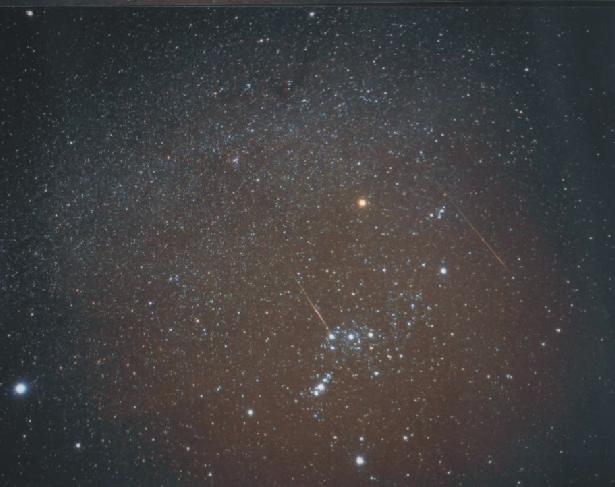 |
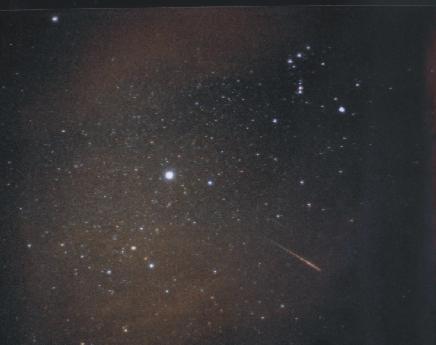 |
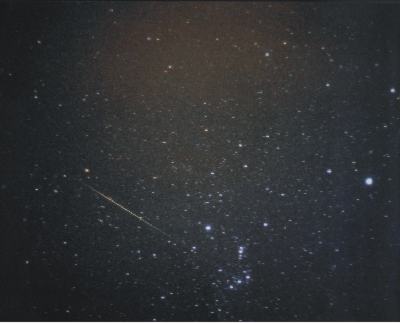 |
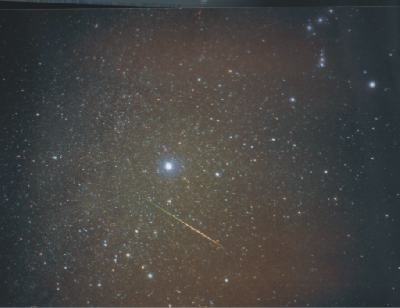 |
By 4:00 you could see the rate declining and it did so at a fairly regular pace till the sky began lightening slightly after 5:00. But even at that point, when several of us were standing, looking at the sky and marveling at what had just happened, the rate seemed to be in excess of 200/hour as every 15 seconds or so, another meteor would streak across the sky. It seemed to me like the period just following a total eclipse of the sun. The excitement surrounding that stunning event makes one pay almost no attention to the partial eclipse still in progress. Similarly, we had just been stunned by the shower of our lives!
As it turned out several frames on both cameras captured bright meteors. In a couple of pictures, I had two meteors. When I thought about it afterwards, it is clear that during many of my exposures, there must have been dozens of meteors that crossed the sky in the field of the camera, but only the very brightest ones were recorded on the film.
After a shower, I said goodbye to our hosts, Ed and Cat Vega, and my observing buddies, Will and Simon and jumped into my car to head back to Phoenix to catch a 2:00 pm flight to BWI. During the drive, I mulled over the past three nights and concluded that coming to Vega-Bray for the Leonids was a great choice. Relative to an east coast site I gained an extra two hours after the 3:10 peak during which I probably saw more than 1000 meteors, got some great telescope time with some very southerly objects not readily seen from home, had some great Mexican food, and got to meet and observe with some new friends.
| Return to the | 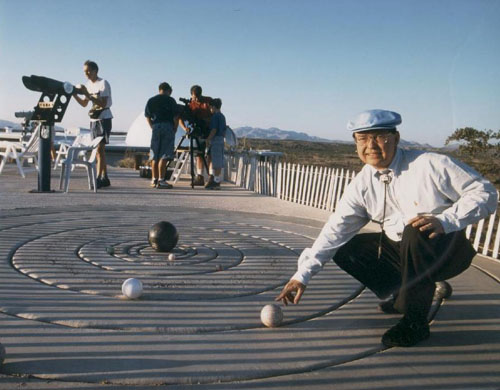 |
The observing deck at
The Skywatcher's Inn with Ed Vega at the model solar system. The 150 mm binoculars in the background |
N.B. Sky and Telescope ran a nice article describing various astronomical resorts. It was in the August, 1999 issue and featured, among others, Vega Bray and the Star Hill Inn. Having now visited both, I now feel that they each have unique offerings. In my opinion, the Star Hill Inn has a better selection of quality scopes and is set in a darker site. However, being high in the Rockies can be tough in the winter, when the climate at Vega Bray is lovely. Additionally, the southern horizon at Vega Bray is far superior to the Star Hill Inn. In both cases the proprietors are wonderful people and make you feel comfortable and at home. So, in the end, it depends on what you are looking for.
Return to the Home Page